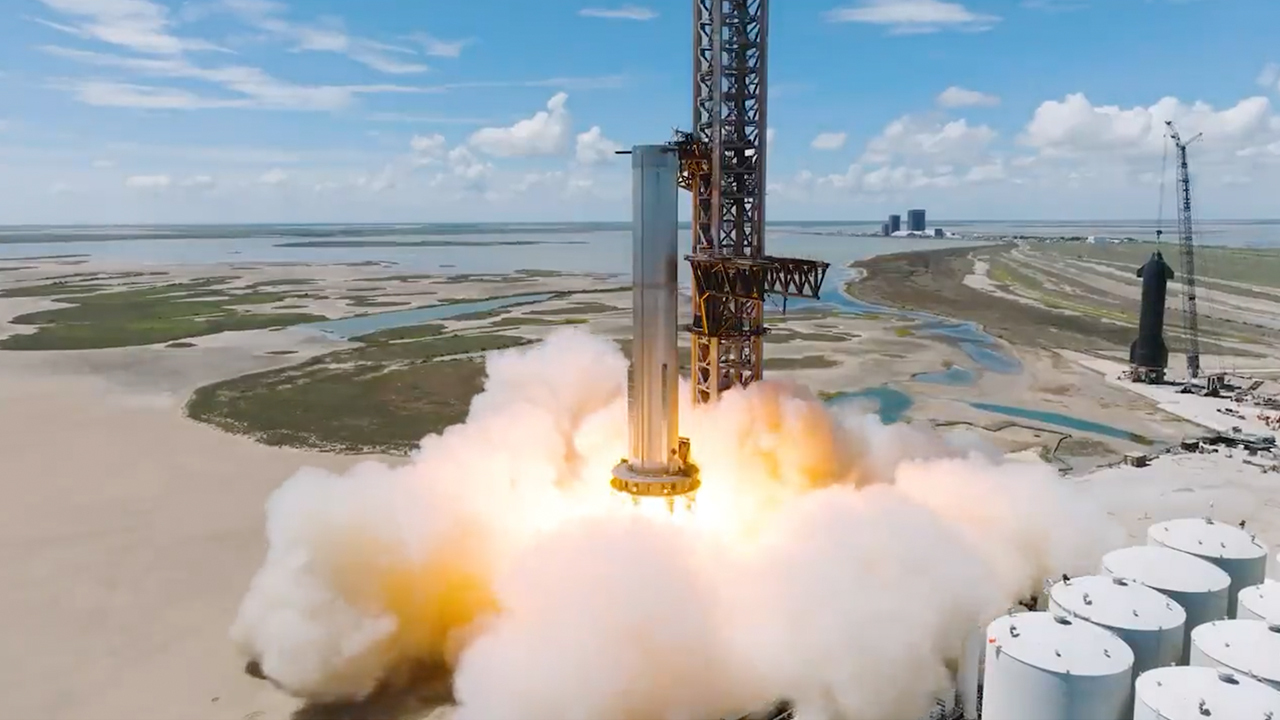
SpaceX's huge Starship Mars rocket could go orbital as soon as next month.
SpaceX is gearing up for the first-ever orbital test flight of Starship, the giant vehicle it's building to take cargo and people to the moon, Mars and other distant destinations. And that landmark try may be just around the corner.
"Late next month maybe, but November seems highly likely. We will have two boosters & ships ready for orbital flight by then, with full stack production at roughly one every two months," company founder and CEO Elon Musk said via Twitter today (Sept. 21), in response to a follower who asked about the timing of the test flight.
Video: SpaceX ignites multiple engines on Starship Super Heavy for 1st time
Starship consists of a huge first-stage booster called Super Heavy and a 165-foot-tall (50 meters) spacecraft known, redundantly, as Starship. Both elements will be fully reusable, and both will be powered by SpaceX's next-generation Raptor engines — 33 for Super Heavy and six for Starship.
If all goes according to plan, the coming orbital flight test will be conducted by prototypes called Booster 7 and Ship 24. SpaceX has been performing engine tests with both vehicles over the past six weeks or so at Starbase, the company's South Texas facility. On Monday (Sept. 19), for example, Booster 7 lit up seven of its 33 Raptors — more engines than it had ever ignited simultaneously before — in a brief "static fire" trial.
Presumably, SpaceX will continue increasing that number in static fires to come, eventually firing up all 33 of Booster 7's Raptors. Once that happens, an orbital launch try will likely be imminent.
Get the Space.com Newsletter
Breaking space news, the latest updates on rocket launches, skywatching events and more!
That test flight will take off from Starbase, sending Ship 24 on an orbital trip that will end with a splashdown in the Pacific Ocean near the Hawaiian island of Kauai. Booster 7 will come down in the Gulf of Mexico, off the Texas coast, not long after liftoff.
But SpaceX is working to build out another Starship launch site as well. The company is modifying historic Launch Pad 39A at NASA's Kennedy Space Center (KSC) in Florida to accommodate launches of Starship, which will be the biggest and most powerful rocket ever to fly.
KSC will likely welcome its first Starship boosters in the spring of 2023, Musk said in another tweet today, "with vehicles initially transferred by boat from Port of Brownsville [in South Texas] to the Cape."
Mike Wall is the author of "Out There" (Grand Central Publishing, 2018; illustrated by Karl Tate), a book about the search for alien life. Follow him on Twitter @michaeldwall. Follow us on Twitter @Spacedotcom or on Facebook.
Join our Space Forums to keep talking space on the latest missions, night sky and more! And if you have a news tip, correction or comment, let us know at: community@space.com.

Michael Wall is a Senior Space Writer with Space.com and joined the team in 2010. He primarily covers exoplanets, spaceflight and military space, but has been known to dabble in the space art beat. His book about the search for alien life, "Out There," was published on Nov. 13, 2018. Before becoming a science writer, Michael worked as a herpetologist and wildlife biologist. He has a Ph.D. in evolutionary biology from the University of Sydney, Australia, a bachelor's degree from the University of Arizona, and a graduate certificate in science writing from the University of California, Santa Cruz. To find out what his latest project is, you can follow Michael on Twitter.









